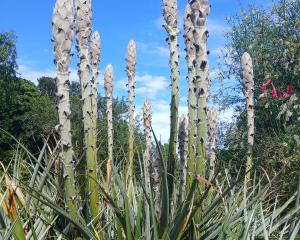A Victorian favourite, dusty millers are still popular, says Gillian Vine.
Adored by Victorian gardeners, who built special theatres in which to display them, dusty miller (Primula auricula) is a sweetly perfumed member of the family that includes polyanthus, cowslip and primrose.
The common name comes from the dusty look of farina or meal on leaves and flowers, although this is absent from the alpine auriculas, one of the four groups into which the plants are classified.
Alpine auriculas have gold or cream centres and the flower colour starts dark at the centre, shading out to a lighter colour on the outer edge, giving a tricolour effect.
The second group is the border type. Used for general garden planting and showing, many look very like alpine auriculas but farina is usually clearly visible on border kinds. The other clue is that border varieties may be a single colour, lacking the shading of the alpines.
Doubles have been around since the 17th century but fell out of favour after 1750, when show auriculas began hogging the limelight. Doubles are now regaining their popularity, in part thanks to people like the late Florence Bellis, of Barnhaven fame, who bred them alongside her famous primroses.
Show specimens are the fourth group and this is where the greatest variation occurs. They are distinguished by an enamel-like centre, known as paste, and green or white edging. The main colour can have lighter streaks and this subgroup ("stripes") is among the most sought-after by British exhibitors. Because rain can damage the flowers, causing the paste to run into the flower colour, it became commonplace to protect prized plants from the weather, and thus the auricula theatre was born.
In every auricula, individual flowers (pips) are bunched in an umbel at the top of a straight stem. They are all descended from a yellow-flowered wild variety, P. auricula, found in alpine parts of Austria and Switzerland.
There are now more than 3000 varieties registered in England, some of them derived from Primula x pubescens (which is a hybrid of P. auricula and P. hirsutan). In this country, there are relatively few named auriculas, particularly in the show group. Rock and alpine garden groups and specialist nurseries are the places to look for named auriculas but even those without formal nomenclature can be extremely appealing additions to the spring garden.
Cultivation is the same for all auriculas. Like other members of the primula family, they need a semi-shaded spot that does not dry out in summer, thrive in well-manured ground and dislike humid conditions. Heavy, clay soil does not suit them, so if necessary work in river gravel or grit to get the optimum drainage so their roots are never waterlogged. Growing them in pots of gritty mix makes it easier to provide the right conditions. Entries in specialist shows need to be in pots, so those with a mind to exhibit have another reason for taking the container route.
Unfortunately, container-grown auriculas need to be repotted every autumn to avoid them developing straggly stems.
Increase plants by taking offshoots from the parent or by growing from seed, which tends to be slow to germinate with seedlings taking a year or more to bloom. The attraction is that growing from seed may give some interesting new varieties.
Auriculas are tough, with no major pests or diseases damaging them.
Root rot may occur if the plants get waterlogged, while slugs and snails will hide under the leaves. It seems, though, that the mealy substance on dusty millers deters insects. Perhaps one day scientists will work out how to gather this farina and use it as a natural pest control on other plants.
Comments
This clever association of flora with era brings to mind the prolific 'settler' hydrangea, of colours many fold, strong stalks and small, clover like petals. If you see hydrangea in the bush, someone had a shanty, by the way, long ago.
'Pansies' were big in the gardens of the industrial working class. They'd been thrown out of the boozer.


















